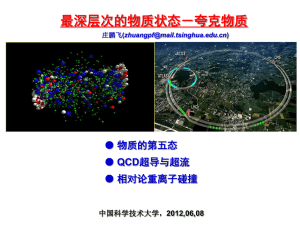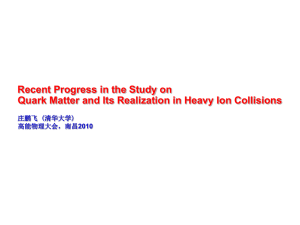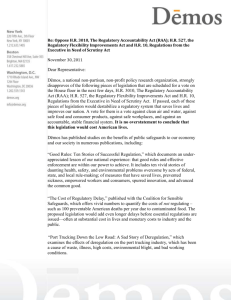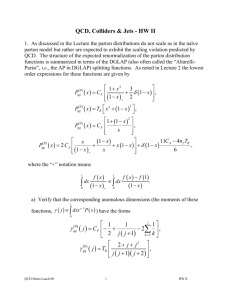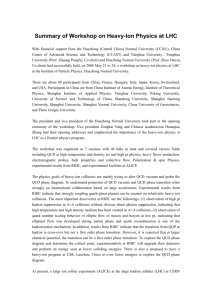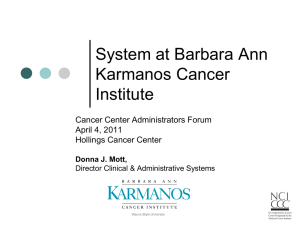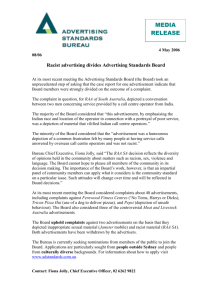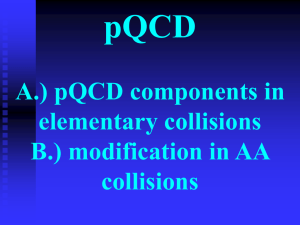1 - Nuclear Theory Group
advertisement
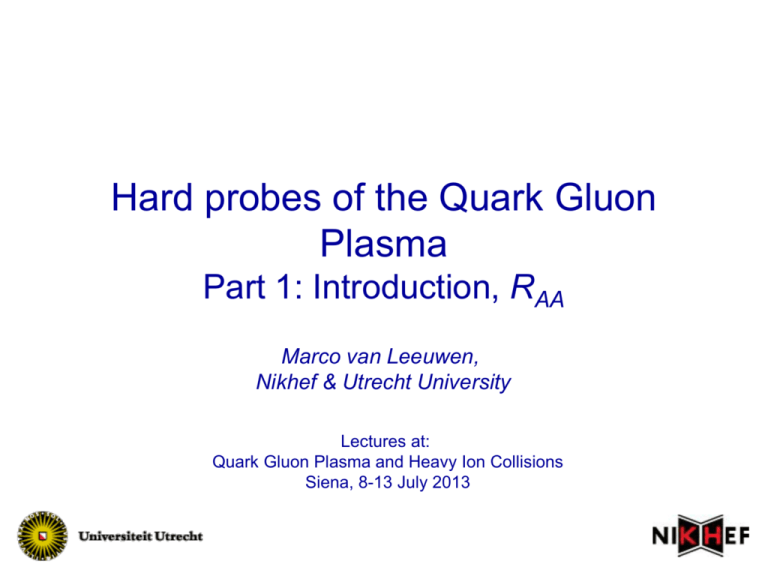
Hard probes of the Quark Gluon Plasma Part 1: Introduction, RAA Marco van Leeuwen, Nikhef & Utrecht University Lectures at: Quark Gluon Plasma and Heavy Ion Collisions Siena, 8-13 July 2013 General QCD references Particle Data Group topical reviews http://pdg.lbl.gov/2004/reviews/contents_sports.html QCD and jets: CTEQ web page and summer school lectures http://www.phys.psu.edu/~cteq/ Handbook of Perturbative QCD, Rev. Mod. Phys. 67, 157–248 (1995) http://www.phys.psu.edu/~cteq/handbook/v1.1/handbook.ps.gz QCD and Collider Physics, R. K. Ellis, W. J. Sterling, D.R. Webber, Cambridge University Press (1996) An Introduction to Quantum Field Theory, M. Peskin and D. Schroeder, Addison Wesley (1995) Introduction to High Energy Physics, D. E. Perkins, Cambridge University Press, Fourth Edition (2000) 2 Heavy Ion references RHIC overviews: P. Jacobs and X. N. Wang, Prog. Part. Nucl. Phys. 54, 443 (2005) B. Mueller and J. Nagle, Ann. Rev. Nucl. Part. Sci. 56, 93 (2006) Jet quenching reviews: M. Spousta, arXiv:1305.6400 J. Caselderrey-Solana and C. Salgado, arXiv:0712.3443 U. Wiedemann, arXiv:0908.2306 A. Majumder and M. v. L. arXiv:1002.2206 Accardi, Arleo et al, arXiv:0907.3534 RHIC experimental white papers BRAHMS: nucl-ex/0410020 PHENIX: nucl-ex/0410003 PHOBOS: nucl-ex/0410022 STAR: nucl-ex/0501009 LHC Yellow Reports 3 Soft QCD matter and hard probes Heavy-ion collisions produce QCD matter Dominated by soft partons p ~ T ~ 100-300 MeV Hard-scatterings produce ‘quasi-free’ partons Initial-state production known from pQCD Probe medium through energy loss ‘Hard Probes’: sensitive to medium density, transport properties 4 Part I: Hard processes in fundamental collisions 5 Accelerators and colliders • p+p colliders (fixed target+ISR, SPPS, TevaTron, LHC) – Low-density QCD – Broad set of production mechanisms • Electron-positron colliders (SLC, LEP) – Electroweak physics – Clean, exclusive processes – Measure fragmentation functions • ep, mp accelerators (SLC, SPS, HERA) Many decisive QCD measurements done – Deeply Inelastic Scattering, proton structure – Parton density functions • Heavy ion accelerators/colliders (AGS, SPS, RHIC, LHC) – Bulk QCD and Quark Gluon Plasma 6 Seeing quarks and gluons In high-energy collisions, observe traces of quarks, gluons (‘jets’) 7 Singularities in pQCD (massless case) Soft divergence Collinear divergence Closely related to hadronisation effects 8 Hard processes in QCD • Hard process: scale Q >> LQCD • Hard scattering High-pT parton(photon) Q ~ pT • Heavy flavour production m >> LQCD Factorization Cross section calculation can be split into • Hard part: perturbative matrix element • Soft part: parton density (PDF), fragmentation (FF) h d pp 0 D d 2 2 h/c K dx dx f ( x , Q ) f ( x , Q ) ( ab cd ) a b a a b b dyd 2 pT dtˆ z c abcd parton density matrix element FF QM interference between hard and soft suppressed (by Q2/L2 ‘Higher Twist’) Soft parts, PDF, FF are universal: independent of hard process 9 The HERA Collider Located in Hamburg The first and only ep collider in the world e± p 27.5 GeV H1 Zeus 920 GeV √s = 318 GeV Equivalent to fixed target experiment with 50 TeV e± 10 Example DIS events NC : e p e X , CC : e p e ( e ) X NC: CC: DIS: Measured electron/jet momentum fixes kinematics: x, Q2 11 Proton structure F2 Q2: virtuality of the g x = Q2 / 2 p q ‘momentum fraction of the struck quark’ F2: essentially a cross section/scattering probability 12 Factorisation in DIS Integral over x is DGLAP evolution with splitting kernel Pqq 13 Parton density distribution Low Q2: valence structure Soft gluons Valence quarks (p = uud) x ~ 1/3 Q2 evolution (gluons) Gluon content of proton rises quickly with Q2 14 p+p dijet at Tevatron Tevatron: p + p at √s = 1.9 TeV Jets produced with several 100 GeV 15 Testing QCD at high energy x = partonic momentum fraction CDF, PRD75, 092006 Dominant ‘theory’ uncertainty: PDFs DIS to measure PDFs Theory matches data over many orders of magnitude Universality: PDFs from DIS used to calculate jet-production Note: can ignore fragmentation effects in jet production 16 pQCD illustrated fragmentation jet spectrum ~ parton spectrum dN 1 n pˆ T dpˆ T pˆ T CDF, PRD75, 092006 z pT ,hadron Pjet h d pp 0 D d 2 2 h/c K dx dx f ( x , Q ) f ( x , Q ) ( ab cd ) a b a a b b dyd 2 pT dtˆ z c abcd 17 Fragmentation and parton showers MC event generators implement ‘parton showers’ Longitudinal and transverse dynamics Hadrons High-energy parton (from hard scattering) large Q2 mF Q ~ mH ~ LQCD Analytical calculations: Fragmentation Function D(z, m) z=ph/Ejet Only longitudinal dynamics 18 Part II: Nuclear Modification Factor RAA 19 RHIC and LHC RHIC, Brookhaven Au+Au sNN= 200 GeV LHC, Geneva Pb+Pb sNN= 2760 GeV STAR First run: 2000 First run: 2009/2010 20 Nuclear geometry: Npart, Ncoll b Two limiting possibilities: - Each nucleon only interacts once, ‘wounded nucleons’ Npart = nA + nB (ex: 4 + 5 = 9 + …) Relevant for soft production; long timescales: Npart - Nucleons interact with all nucleons they encounter Ncoll = nA x nB (ex: 4 x 5 = 20 + …) Relevant for hard processes; short timescales: Nbin Transverse view Density profile r: rpart or rcoll Eccentricity 2 y 2 y 2 x 2 x y L x 21 Centrality dependence of hard processes Total multiplicity: soft processes Binary collisions weight towards small impact parameter d/dNch 200 GeV Au+Au Rule of thumb for A+A collisions (A>40) 40% of the hard cross section is contained in the 10% most central collisions 22 Testing volume (Ncoll) scaling in Au+Au Direct g spectra PHENIX, PRL 94, 232301 PHENIX Centrality RAA dN / dpT Au Au N coll dN / dpT p p Scaled by Ncoll Direct g in A+A scales with Ncoll A+A initial state is incoherent superposition of p+p for hard probes 23 0 RAA – high-pT suppression g: RAA = 1 0: RAA ≈ 0.2 g: no interactions RAA = 1 Hadrons: energy loss RAA < 1 Hard partons lose energy in the hot matter 24 Nuclear modification factor R AA dN / dpT Pb Pb N coll dN / dpT p p Suppression factor 2-6 Significant pT-dependence Similar at RHIC and LHC? So what does it mean? 25 Nuclear modification factor RAA ‘Energy loss’ 1/Nbin d2N/d2pT R AA dN / dpT Pb Pb N coll dN / dpT p p ‘Absorption’ p+p Downward shift Shifts spectrum to left Au+Au pT Measured RAA is a ratio of yields at a given pT The physical mechanism is energy loss; shift of yield to lower pT 26 Getting a sense for the numbers – RHIC 0 spectra Nuclear modification factor PHENIX, PRD 76, 051106, arXiv:0801.4020 Oversimplified calculation: - Fit pp with power law - Apply energy shift or relative E loss Not even a model ! Ball-park numbers: DE/E ≈ 0.2, or DE ≈ 3 GeV for central collisions at RHIC 27 From RHIC to LHC RHIC: 200 GeV per nucleon pair LHC: 2.76 TeV Energy ~24 x higher LHC: spectrum less steep, larger pT reach 1 dN pT n 2 pT dpT RHIC: n ~ 8.2 LHC: n ~ 6.4 Fractional energy loss: R AA DE 1 E n2 RAA depends on n, steeper spectra, smaller RAA 28 From RHIC to LHC RHIC LHC RHIC: n ~ 8.2 1 0.23 6. 2 0.20 LHC: n ~ 6.4 1 0.234.4 0.32 Remember: still ‘getting a sense for the numbers’; this is not a model! 29 Towards a more complete picture • Energy loss not single-valued, but a distribution • Geometry: density profile; path length distribution • Energy loss is partonic, not hadronic – Full modeling: medium modified shower – Simple ansatz for leading hadrons: energy loss followed by fragmentation – Quark/gluon differences 30 Medium-induced radiation Landau-Pomeranchuk-Migdal effect Formation time important radiated gluon propagating parton Radiation sees length ~tf at once tf 2 kT2 Energy loss depends on density: and nature of scattering centers (scattering cross section) Transport coefficient qˆ q2 Energy loss DEmed ~ S C R qˆ Ln F (m, E ) CR: color factor (q, g) q̂ : medium density L: path length m: parton mass (dead cone eff) E: parton energy 1 r Path-length dependence Ln n=1: elastic n=2: radiative (LPM regime) n=3: AdS/CFT (strongly coupled) 31 Four formalisms Multiple gluon emission • Hard Thermal Loops (AMY) – Dynamical (HTL) medium – Single gluon spectrum: BDMPS-Z like path integral – No vacuum radiation • Multiple soft scattering (BDMPS-Z, ASW-MS) – Static scattering centers – Gaussian approximation for momentum kicks – Full LPM interference and vacuum radiation • Opacity expansion ((D)GLV, ASW-SH) – Static scattering centers, Yukawa potential – Expansion in opacity L/ (N=1, interference between two centers default) – Interference with vacuum radiation • Fokker-Planck rate equations Poisson ansatz (independent emission) Higher Twist (Guo, Wang, Majumder) – Medium characterised by higher twist matrix elements – Radiation kernel similar to GLV – Vacuum radiation in DGLAP evolution DGLAP evolution See also: arXiv:1106.1106 32 Large angle radiation Emitted gluon distribution Gluon perp momentum k (GeV) Opacity expansion kT < k Gluon momentum k (GeV) Calculated gluon spectrum extends to large k at small k Outside kinematic limits GLV, ASW, HT cut this off ‘by hand’ 33 Effect of large angle radiation Single-gluon spectrum Expand in powers of Blue: kTmax = xE Red: kTmax = 2x(1-x)E L Different definitions of x: ASW: x E E GLV: x Horowitz and Cole, PRC81, 024909 Opacity expansion formalisms E Different large angle cut-offs: kT < = xE E kT < = 2 x+ E Factor ~2 uncertainty from large-angle cut-off 34 Energy loss distributions Radiated gluon distribution Main theory uncertainty: Large angle radiation Multiple gluon emission: Energy loss probability distribution Poisson Ansatz Broad distribution Significant contributions at DE=0, DE=E 35 Energy loss formalisms • Large differences between formalisms understood – Large angle cut-off – Length dependence (interference effects) • Mostly ‘technical’ issues; can be overcome – Use path-integral formalism – Monte Carlo: exact E, p conservation • Full 2→3 NLO matrix elements • Include interference • Next step: interference in multiple gluon emission Plenty of room for interesting and relevant theory work! 36 Geometry Density profile Profile at t ~ tform known Density along parton path Longitudinal expansion dilutes medium Important effect Space-time evolution is taken into account in modeling 37 A simplified approach Parton spectrum Energy loss distribution Fragmentation (function) dN dpT hadr dN dE P(DE ) D( pT ,hadr / E jet ) jets known pQCDxPDF extract `known’ from e+e- This is where the information about the medium is P(DE) combines geometry with the intrinsic process – Unavoidable for many observables Notes: • This is the simplest ansatz – most calculation to date use it (except some MCs) • Jet, g-jet measurements ‘fix’ E, removing one of the convolutions – more in Lecture 2 and 3 38 RAA at RHIC: ‘calibrating’ the models ASW: HT: AMY: qˆ 10 20 GeV 2 /fm qˆ 2.3 4.5 GeV 2 /fm qˆ 4 GeV 2 /fm Large density: AMY: T ~ 400 MeV Transverse kick: qL ~ 10-20 GeV Bass et al, PRC79, 024901 PHENIX, arXiv:1208.2254 All calculations describe the data Not very sensitive to energy loss distribution Large uncertainty in absolute medium density 39 RAA at LHC & models ALICE: arXiv:1208.2711 CMS: arXiv:1202.2554 Broad agreement between models and LHC RAA Extrapolation from RHIC tends to give too much suppression at LHC Many model curves: need more constraints and/or selection of models 40 RAA at LHC and JEWEL JEWEL: Monte Carlo event generator with radiative+collisional energy loss - Modified showers with MC-LPM implementation - Geometry: expanding Woods-Saxon density Suppression factor 2-6 Significant pT-dependence JEWEL energy loss model agrees with measurements (tuned at RHIC, LHC ‘parameter-free’) 41 Identified hadron RAA M. Ivanov, A. Ortiz@QM2012 Low-intermediate pT (1-6 GeV): Large baryon/meson ratio Probably due to: 1) radial flow 2) parton recombination M. Ivanov, A. Ortiz@QM2012 Baryon, meson RAA similar at pT > 8 GeV As expected from parton energy loss 42 Identified hadron RAA (strangeness) L: RAA~1 at pT~3 GeV/c Smaller suppression, L/K enhanced at low pT Kaon, pion RAA similar pT ~8 GeV/c: All hadrons similar partonic energy loss + pp-like fragmentation? 43 Summary • QCD calculations: factorisation of perturbative and universal non-perturbative components (PDFs, FFs) – Except e+e-: no PDF needed • Heavy ion collisions: jet quenching – First observable: RAA – Qualitatively: large effect, several GeV lost or DE/E ~ 0.2 – Detailed modeling: • Some ‘intrinsic’ uncertainties • In progress – more in next lectures 44 Effects in RAA • Parton pT spectra – – • Quark vs gluon jets – – • – Larger density at LHC more suppression (profile similar?) Path length dependence of energy loss Parton energy dependence – – • More gluon jets at LHC more suppression More quark jets at high pT: RAA rises ‘Known’, external input Medium density (profile) – • Less steep at LHC less suppression Steepness decreases with pT: RAA rises Expect slow (log) increase of DE with E RAA rises with pT Running of S (A Buzzatti@QM2012) ? Energy loss distribution – Expect broad distribution P(DE); kinematic bounds important Energy loss theory Determine/ constrain from measurements Use different observables to disentangle effects contributions 45 Extra slides 46 Intermezzo: Centrality Nuclei are large compared to the range of strong force Peripheral collision Central collision top view: b b finite b~0 fm front view: Size of reaction zone, density depends on centrality: No QGP effects in peripheral collisions 47 Centrality continued central peripheral Multiplicity distribution Experimental measure of centrality: multiplicity 48 Note: difference p+p, e++e- p+p: steeply falling jet spectrum Hadron spectrum convolution of jet spectrum with fragmentation e+ + e- QCD events: jets have p=1/2 √s Directly measure frag function 49 Multiple soft scattering: BDMPS, AMY L=2 fm Single gluon spectra L=5 fm Single gluon spectra AMY: no large angle cut-off + sizeable difference at large at L=2 fm Using qˆ (T ) based on AMY-HTL scattering potential 50 L-dependence; regions of validity? Emission rate vs t (=L) Caron-Huot, Gale, arXiv:1006.2379 E = 16 GeV k = 3 GeV T = 200 MeV GLV N=1 Too much radiation at large L (no interference between scatt centers) Full = numerical solution of Zakharov path integral = ‘best we know’ AMY, small L, no L2, boundary effect H.O = ASW/BDMPS like (harmonic oscillator) Too little radiation at small L (ignores ‘hard tail’ of scatt potential) 51 So what are we trying to do... • First: understand (parton) energy process – Magnitude, dominant mechanism(s) – Probability distribution • Lost energy • Radiated gluons/fragments – Path length dependence – Flavour/mass dependence – Large angle radiation? • Future: use this to learn about the medium 52 Jet Quenching 1) How is does the medium modify parton fragmentation? (from hard scattering) Hadrons • Energy-loss: reduced energy of leading hadron – enhancement of yield at low pT? • Broadening of shower? • Path-length dependence • Quark-gluon differences High-energy • Final stage of fragmentation outside medium? parton 2) What does this tell us about the medium ? • Density • Nature of scattering centers? (elastic vs radiative; mass of scatt. centers) • Time-evolution? 53 Larger suppression + spectrum less steep: larger density PHENIX: arXiv:1208.2254 LHC RAA < RHIC RAA RAA at RHIC and LHC Increase of RAA with pT similar at RHIC and LHC Increase of RAA with pT: Decrease of relative energy loss ΔE/E with pT and/or decrease of power law index with pT (e.g. change from gluon to quark) 54 Jets in pp at √s=2.76 TeV EMCAL installed in Dec 2010: |h|<0.8, j ~/3 R. Ma@HP Charged tracks+EMCAL, R=0.4 R=0.2/R=0.4 Reasonable agreement with NLO calculations Need to include hadronisation for jet shapes 55 Singularities in phase space 56 Mechanisms for modified jet chemistry In-medium color flow/reconnection ‘Shower-thermal’ recombination Baryon pT=3pT,parton Meson pT=2pT,parton Hot matter Hard parton (Hwa, Yang) Expect large baryon/meson ratio associated with high-pT trigger Sapeta, Wiedemann, arXiv:0707.3494 Milhano et al 57
